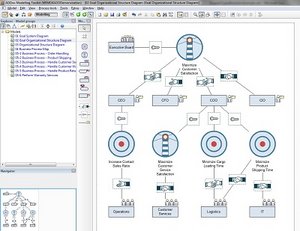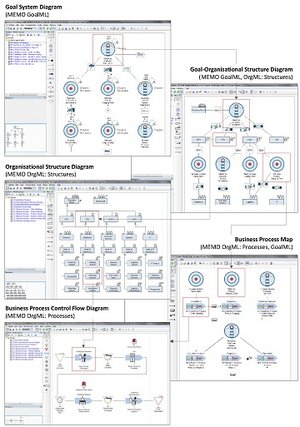MEMO4ADO
Introduction

The modeling tool MEMO4ADO implements a subset of MEMO, a method for Multi-Perspective Enterprise Modeling, which encompasses a set of integrated domain-specific modeling languages (DSMLs) to describe and interrelate different aspects of an enterprise, covering both its organizational action system (e.g., goals, organizational structure, and business processes) and information systems (e.g., IT infrastructures and object models).
MEMO4ADO implements a carefully edited subset of MEMO, providing a comprehensive and elaborate enterprise modeling environment. The current tool version implements parts of six integrated domain-specific modeling languages. This includes languages to model organizational goal systems (MEMO GoalML), organizational structures (MEMO OrgML: Structures), business processes (MEMO OrgML: Processes), IT infrastructures (MEMO ITML), decision processes (MEMO DecisionML), and business performance indicators (MEMO MetricML).
MEMO4ADO enables to create various diagram types covering these different areas of an organization (e.g., goal system diagrams and business process diagrams). In addition, diagram types are available which permit to interrelate elements from the different specific perspectives (e.g., diagrams interrelating goals and organizational structures), such as to achieve a truly integrated, multi-perspective view of an enterprise.
Further details regarding MEMO and MEMO4ADO are found here. Research publications concerning the theoretical background, design processes, and details of the various MEMO modeling languages are found on the Publications section. You can download the tool on the Download page . In order to get started using MEMO and MEMO4ADO, the Tutorials section provides you with various helpful resources and examples.
Multi-Perspective Enterprise Modeling (MEMO)
MEMO is a method for Multi-Perspective Enterprise Modeling, which encompasses a set of integrated domain-specific modeling languages (DSMLs) to describe a variety of aspects related to an organization’s action system (including, e.g., goals, organizational structure, and business processes) and information systems (including, e.g., IT infrastructures). Integrative links between the various MEMO modeling languages permit to interrelate model elements from organizational and information-technological areas, enabling to build an integrated, multi-disciplinary view of an organization.
Overview and How To Start

The tool MEMO4ADO is a comprehensive enterprise modeling tool implementing subsets of several highly elaborate, integrative, and research-based domain-specific enterprise modeling languages of MEMO. In particular, the current version of MEMO4ADO (1.3) includes six modeling languages (explained below): The MEMO GoalML, MEMO OrgML: Structures, MEMO OrgML: Processes, MEMO ITML, MEMO DecisionML, and MEMO MetricML. Based on these modeling languages, the tool currently provides more than ten diagram types (for a selection, see the figure). The tool is also intended to offer an accessible enterprise modeling environment to grasp the notion of multi-perspective enterprise modeling.
The modeling language MEMO GoalML enables to describe organizational goal systems. The language MEMO OrgML: Structures allows to model organizational structures. The language MEMO OrgML: Processes permits to describe business processes. The language MEMO ITML permits to describe IT infrastructures at a high level of detail, covering software elements, hardware elements, and ample additional abstractions (such as communication relationships and service abstractions). The language MEMO DecisionML enables to describe decision processes in the context of an organization, including problem-analytical decision premises, organizational responsibilities, and relationships to IT decision support. The language MEMO MetricML allows to describe and analyze business performance indicators in a reflective fashion, directing attention at the justification and careful interpretation of indicator systems.
For each modeling language, MEMO4ADO provides the ability to create diagrams of specific types (e.g., goal system diagrams using MEMO GoalML; see the left-hand side of the above figure). Furthermore, all modeling languages are integrated and interrelations among diagrams can be expressed by means of references between different diagrams as well as specific integrative diagram types (see the right-hand side of the above figure). More MEMO modeling languages will be added to MEMO4ADO in the future.
To start using MEMO and MEMO4ADO, this project page provides you with a variety of resources.
- To download the tool see the download section below.
- To guide you in installing and setting up MEMO4ADO, please consult the Tutorial section below .
- The articles available in the publication section provide overview on the conceptual foundation of MEMO and basic features of the modeling tool MEMO4ADO. There you may also find additional resources providing details regarding the various MEMO modeling languages.
MEMO4AADO: Download
Here the most recent version of MEMO4ADO can be downloaded as a standalone application.
Disclaimer:
Please note that the provided package represents work in progress. Additional MEMO modeling languages and features will be added or modified in the future.
Tutorials
Here we provide you with additional material to get started with MEMO4ADO, to get a fuller view of the MEMO method by exploring more extensive example models, and to learn about the tool's advanced capabilities in more detail.
In order to support you in getting started with MEMO4ADO, the following tutorial videos provide guidance on preparing and working with the tool.
Introduction to MEMO
In order to grasp central ideas of MEMO4ADO it seems advisable to learn about central ideas of Multi-perspective Enterprise Modeling (MEMO). The slides of the video can be found here.
MEMO4ADO Walkthrough
In this video different functions of MEMO4ADO are shown by constructing a first Enterprise Model. The larger Enterprise Model used at the end of the video can be downloaded here.
MEMO & MEMO4ADO in Detail
This video elaborates more ideas of MEMO and MEMO4ADO more in detail. If you are interested in certain aspects take a look into this timetable.
Example Models
In order to provide a fuller overview of MEMO4ADO and the MEMO modeling languages, the here provided example model integratively describes an enterprise from different perspectives using all the different MEMO modeling languages. It is one of the most comprehensive example enterprise models freely available.
Research Publications
Overview Articles
The following introductory articles summarize the conceptual foundation of MEMO and describe the capabilities and design process of the ADOxx implementation, MEMO4ADO. Publications concerning specific MEMO modeling languages and advanced aspects of meta modeling are listed in the categories below.
MEMO:
- Frank, U. 2014. “Multi-perspective enterprise modeling: foundational concepts, prospects and future research challenges,” Software & Systems Modeling (13:3), pp. 941–962.
MEMO4ADO:
- Bock, A., and Frank, U. 2016. “Multi-Perspective Enterprise Modeling – Conceptual Foundation and Implementation with ADOxx,” in Domain-Specific Conceptual Modeling: Concepts, Methods and Tools, D. Karagiannis, H. C. Mayr and J. Mylopoulos (eds.), Berlin, Heidelberg, New York: Springer.
- Frank, U.; Bock, A.: Conjoint Analysis and Design of Business and IT: The Case for Multi-Perspective Enterprise Modeling. In: Kulkarni, V.; Reddy, S.; Clark, T.; Barn, B. (Hrsg.): Advanced Digital Architectures for Model-Driven Adaptive Enterprises. IGI Global, 2020, S. 15-45. doi:10.4018/978-1-7998-0108-5.ch002
Specific MEMO DSMLs
The following articles describe the domain-specific modeling languages (DSMLs) of which MEMO is composed. The publications discuss theoretical backgrounds of the languages, describe related design processes, and present complete language specifications, including meta models, additional constraints, and in-depth explanations of all modeling concepts.
MEMO GoalML (Goal Modeling Language):
- Bock A., Frank U. 2016. MEMO GoalML: A Context-Enriched Modeling Language to Support Reflective Organizational Goal Planning and Decision Processes. In: Comyn-Wattiau I., Tanaka K., Song I.-Y., Yamamoto S., Saeki M. (eds.) Conceptual Modeling. 35th International Conference, ER 2016, Gifu, Japan, November 14-17, 2016, Proceedings. Springer, Cham, pp. 515–529.
- Köhling, C. A. 2013. Entwurf einer konzeptuellen Modellierungsmethode zur Unterstützung rationaler Zielplanungsprozesse in Unternehmen, Göttingen: Cuvillier.
- Overbeek, S. J., Frank, U., and Köhling, C. 2015. “A language for multi-perspective goal modelling: Challenges, requirements and solutions,” Computer Standards & Interfaces (38:February), pp. 1–16.
MEMO DecisionML (Decision Modeling Language):
- Bock A. 2015. Beyond Narrow Decision Models: Toward Integrative Models of Organizational Decision Processes. In: 17th IEEE Conference on Business Informatics (CBI 2015). IEEE Computer Society, pp. 181–190.
- Bock A., Kattenstroth H., Overbeek S. J. 2014. Towards a Modeling Method for Supporting the Management of Organizational Decision Processes. In: Fill H.-G., Karagiannis D., Reimer U. (eds.) Modellierung 2014. 19. - 21. März 2014, Wien, Österreich. Gesellschaft für Informatik, Bonn, pp. 49–64.
MEMO MetricML (Performance Measurement Modeling Language):
- Strecker S., Frank U., Heise D., Kattenstroth H. 2012. MetricM: A modeling method in support of the reflective design and use of performance measurement systems. Information Systems and E-Business Management 10(2):241–276.
MEMO OrgML (Organization Modeling Language):
- Frank, U. 2011. “MEMO Organisation Modelling Language (1) – Focus on Organisational Structure,” ICB Research Report 48, University of Duisburg-Essen, Essen.
- Frank, U. 2011. “MEMO Organisation Modelling Language (2) – Focus on Business Processes,” ICB Research Report 49, University of Duisburg-Essen, Essen.
MEMO ITML (IT Modeling Language):
- Frank, Ulrich; Kaczmarek-Heß, Monika; De Kinderen, Sybren: IT Infrastructure Modeling Language (ITML): A DSML for Supporting IT Management - ICB Research Report. 72. Essen 2021. doi:10.17185/duepublico/75252
- Heise, D. 2013. Unternehmensmodell-basiertes IT-Kostenmanagement als Bestandteil eines integrativen IT-Controllings, Berlin: Logos.
Background and Advanced Reading
The following publications discuss advanced aspects of MEMO (e.g., the meta modeling language MEMO MML) as well as the (historical) background of the method.
- Frank, U. 2011. “The MEMO Meta Modelling Language (MML) and Language Architecture: 2nd Edition,” ICB Research Report 43, University of Duisburg-Essen, Essen.
- Frank, U. 1994. Multiperspektivische Unternehmensmodellierung: Theoretischer Hintergrund und Entwurf einer objektorientierten Entwicklungsumgebung, München: Oldenbourg.
- Frank, U. 2002. “Multi-Perspective Enterprise Modeling (MEMO): Conceptual Framework and Modeling Languages,” in Proceedings of the 35th Hawaii International Conference on System Sciences: 7-10 January 2002, Big Island, Hawaii, R. H. Sprague, Jr. (ed.), Big Island, HI, USA. January 7-10, 2002, Los Alamitos: IEEE Computer Society.
Current Research and Future Directions
The following articles discuss directions into which future developments of MEMO is headed. In particular, this includes transfering the modeling method to a novel modeling paradigm—multi-level conceptual modeling—for which tool support is underway.
- Frank U. 2014. Multilevel Modeling: Toward a New Paradigm of Conceptual Modeling and Information Systems Design. Business & Information Systems Engineering 6(6):319–337.
Members
Prof. Dr. Ulrich Frank (Projektleiter)
M. Sc. Alexander Bock (verantwortlicher Mitarbeiter)
Dr. Monika-Kaczmarek-Heß (ehemalige Mitarbeiterin)
Daniel Heinzig (ehemaliger studentischer Mitarbeiter)
Oliver Just (ehemaliger studentischer Mitarbeiter)
Joscha Hofer (ehemaliger studentischer Mitarbeiter)
Prof. Dr. Stefan Strecker (ehemaliger Mitarbeiter)
Dipl.-Wirt.-Inf. Heiko Kattenstroth (ehemaliger Mitarbeiter)
David Becher (ehemaliger studentischer Mitarbeiter)
